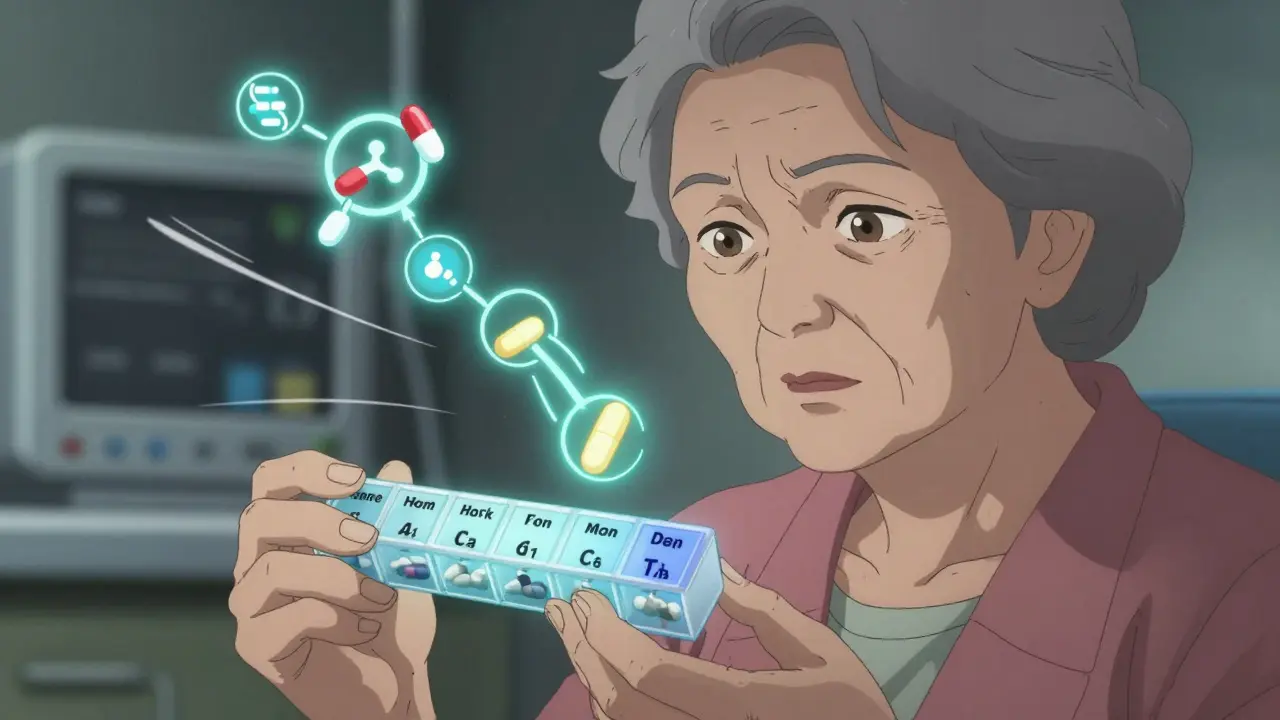Megaloblastic Anemia from Folic Acid Deficiency: Causes, Risks & Prevention

Megaloblastic anemia due to folic acid deficiency is a type of macrocytic anemia that occurs when insufficient folate impairs DNA synthesis, leading to oversized, immature red blood cells. It manifests with fatigue, pallor, and sometimes neurological signs, and it can be reversed once the folate shortfall is corrected.
What Triggers Folate Shortage?
Understanding the root causes helps you avoid the cascade that ends in megaloblastic anemia. Below are the most common drivers:
- Inadequate dietary intake is the simplest explanation-think low‑leaf‑green diets or strict low‑carb regimens that cut out fortified breads.
- Alcoholism interferes with folate absorption and liver storage.
- Malabsorption syndromes such as celiac disease, inflammatory bowel disease, or bariatric surgery.
- Certain medications - notably antimetabolites like methotrexate and anticonvulsants such as phenytoin - block folate pathways.
- Pregnancy dramatically raises folate demand for fetal neural‑tube development.
How Folate Connects to Red Blood Cell Maturation
At the cellular level, folic acid (vitamin B9) is a co‑factor in DNA synthesis. Without enough folate, the nucleus of a developing erythroblast cannot replicate its genetic material efficiently. The result is a delayed cell cycle, producing large, nuclei‑filled precursors that spill into circulation as macrocytes. This failure is captured in a peripheral blood smear:
Hyper‑segmented neutrophils and oval macro‑o‑red cells are hallmarks of folate‑related megaloblastic anemia.
In contrast, vitamin B12 deficiency also hampers DNA synthesis but adds a neurological component because B12 is vital for myelin formation. Distinguishing the two is crucial for proper treatment.
Risk Groups That Need Extra Folate
While anyone can develop folate deficiency, some populations are especially vulnerable:
- Women of childbearing age - folic acid is essential for preventing neural‑tube defects.
- Elderly individuals - reduced gastric acid secretion limits folate release from food.
- Chronic alcohol users - liver damage curtails folate storage.
- Patients on chronic methotrexate therapy for rheumatoid arthritis or psoriasis.
- Individuals with gastrointestinal surgeries that bypass the duodenum, the main absorption site.
Comparing Folate‑ vs B12‑Related Megaloblastic Anemia
| Attribute | Folate Deficiency | Vitamin B12 Deficiency |
|---|---|---|
| Primary Role | DNA synthesis (pyrimidine production) | DNA synthesis & myelin maintenance |
| Typical Causes | Low intake, alcoholism, malabsorption, drugs | Intrinsic factor loss, pernicious anemia, vegan diet |
| Neurologic Symptoms | Rare | Common - peripheral neuropathy, gait disturbances |
| Serum Markers | Low serum folate, normal B12 | Low B12, elevated methylmalonic acid |
| Treatment | Folate supplementation (400‑800µg/day) | B12 injections or high‑dose oral B12 |

Diagnostic Work‑up: From Symptoms to Lab Values
Clinicians follow a stepwise approach:
- Clinical assessment - look for fatigue, glossitis, and macrocytosis.
- Complete blood count - mean corpuscular volume (MCV) typically >100fL.
- Serum folate and vitamin B12 levels - rule out overlap.
- Homocysteine and methylmalonic acid - elevated homocysteine appears in both deficiencies, but only B12 deficiency raises methylmalonic acid.
- Bone‑marrow biopsy (rare) - shows megaloblastic changes when peripheral tests are inconclusive.
These tests create a semantic web: folate level affects MCV, which correlates with red‑cell maturation, which depends on DNA synthesis.
Practical Prevention Strategies
Prevention is a blend of diet, lifestyle, and medical oversight:
- Consume a folate‑rich diet - leafy greens, beans, citrus, and fortified grains provide 200‑400µg of folate per serving.
- Consider supplements - especially for women planning pregnancy (400µg daily) or people on methotrexate.
- Limit alcohol intake - excessive consumption (>2 drinks/day) depletes folate stores.
- Monitor high‑risk patients - routine labs for those with gastrointestinal disease or on antifolate drugs.
- Educate about drug interactions - antacids and certain antibiotics can hinder folate absorption.
Related Concepts and Next Steps in the Knowledge Cluster
This article sits within a broader health‑and‑medicine cluster that includes:
- Macrocytic anemia - the umbrella term covering all large‑cell anemias.
- Nutrition during pregnancy - how folate, iron, and iodine intersect.
- Drug‑induced hematologic disorders - a deeper look at methotrexate, sulfonamides, and chemotherapy agents.
- Homocysteine metabolism - links between folate, B12, cardiovascular risk, and mental health.
- Gastrointestinal malabsorption - celiac disease, Crohn’s disease, and their hematologic impact.
Readers interested in the biochemical side can explore “DNA synthesis pathways” or “one‑carbon metabolism.” Those focused on clinical practice might jump to “Managing anemia in pregnancy” or “Monitoring patients on antifolate therapy.”
Key Takeaways
Summarizing the most actionable points:
- Folate deficiency is a preventable cause of megaloblastic anemia; diet and targeted supplementation are the first line.
- Distinguish it from vitamin B12 deficiency because treatment and neurologic outcomes differ.
- High‑risk groups - pregnant women, alcohol users, patients on methotrexate, and those with malabsorption - need regular folate screening.
- Early detection via CBC and serum folate can halt disease progression before severe symptoms appear.

Frequently Asked Questions
Can folic acid deficiency cause permanent damage?
If caught early and treated with oral folate, the anemia usually resolves completely. Permanent neurologic damage is rare, unlike B12 deficiency, which can leave lasting deficits.
How much folic acid should I take if I’m pregnant?
Health authorities recommend 400µg of folic acid daily for women of childbearing age, increasing to 600‑800µg during pregnancy to support fetal neural‑tube closure.
Why does methotrexate cause megaloblastic anemia?
Methotrexate blocks dihydrofolate reductase, preventing conversion of dietary folate into its active form. This enzymatic roadblock impairs DNA synthesis, leading to the characteristic large, immature red cells.
Is a blood smear enough to diagnose folate‑related anemia?
A peripheral smear shows macrocytosis and hyper‑segmented neutrophils, but definitive diagnosis requires serum folate measurement and exclusion of B12 deficiency.
Can a vegetarian diet lead to folate deficiency?
Vegetarians typically have ample folate due to high intake of legumes and greens. However, if the diet is overly processed or lacks variety, deficiency can still occur.






Comments
Justin Atkins
September 26, 2025 AT 14:48Folate acts as a pivotal one‑carbon donor in the synthesis of thymidylate, and without it the erythroid lineage stalls in the S‑phase, producing macrocytic cells. The literature consistently shows that diets lacking leafy greens or fortified grains predictably lower serum folate levels. Moreover, chronic alcohol consumption impairs hepatic storage, compounding the deficit. Clinicians therefore prioritize a CBC followed by serum folate to differentiate from cobalamin deficiency.
June Wx
September 27, 2025 AT 10:48Ugh, I can’t even with people who think skipping veggies is a lifestyle choice! It’s literally a recipe for anemia, and the fatigue hits hard.
kristina b
September 28, 2025 AT 06:48The intricate ballet of one‑carbon metabolism orchestrates not only nucleic acid synthesis but also the methylation of countless biomolecules. When folate availability wanes, this choreography collapses, leaving nascent erythroblasts stranded in a state of arrested proliferation. The resultant macrocytes, with their enlarged cytoplasmic volume, are the hematologic hallmark of megaloblastic anemia. Yet the story does not end at the marrow; hyper‑segmented neutrophils parade through the peripheral smear as silent witnesses to the underlying biochemical turmoil. In pregnant individuals, the stakes ascend dramatically, for the developing neural tube depends on a steady supply of methyl groups derived from folate. Consequently, public health policies mandate supplementation of 400 µg of folic acid daily for women of childbearing age, a measure that has slashed the incidence of spina bifida worldwide. Conversely, patients on antifolate agents such as methotrexate confront iatrogenic depletion, a risk that must be mitigated with leucovorin rescue or supplemental folate. Alcoholic populations suffer a double blow: the toxin not only depletes hepatic stores but also disrupts intestinal absorption, forging a perfect storm for deficiency. Dietary patterns low in cruciferous vegetables, legumes, and fortified grains further erode the folate pool, especially in low‑carbohydrate regimens that eschew grain‑based foods. The diagnostic algorithm therefore commences with a thorough history, proceeds to a complete blood count, and culminates in quantitative serum folate measurement. Elevated homocysteine, while nonspecific, can flag a folate shortfall when methylmalonic acid remains within normal limits. Therapeutically, oral folic acid at doses of 400–800 µg per day restores erythropoiesis within weeks, and the morphological abnormalities recede in tandem. It is essential, however, to differentiate this entity from vitamin B12 deficiency, for the latter harbors irreversible neurologic sequelae if left untreated. In clinical practice, the temptation to prescribe a blind high‑dose vitamin cocktail must be resisted in favor of targeted therapy guided by laboratory data. Ultimately, the prevention of folate‑related megaloblastic anemia resides at the intersection of nutrition, vigilant monitoring, and patient education, a triumvirate that empowers individuals to guard their hematologic health.
Ida Sakina
September 29, 2025 AT 02:48Folates are essential nutrients that support DNA synthesis and red cell formation. Deficiency leads to macrocytic anemia and must be corrected promptly. The best prevention is a balanced diet rich in leafy greens.
Amreesh Tyagi
September 29, 2025 AT 22:48People love to blame diet but they forget genetics also play a role
Brianna Valido
September 30, 2025 AT 18:48Got my folic acid tablets ready for the new season 😊
Caitlin Downing
October 1, 2025 AT 14:48I think it’s super important to check ur folate levels especially if u’re on meds like methotrexate. Definately worth the extra blood test.
Robert Jaskowiak
October 2, 2025 AT 10:48Oh sure, because everyone just loves getting jabbed with needles for a vitamin you could eat in a salad. Real smooth, health care.
Julia Gonchar
October 3, 2025 AT 06:48Serum folate below 3 ng/mL is typically diagnostic for deficiency.
Annie Crumbaugh
October 4, 2025 AT 02:48Just another reminder to add some spinach to your grocery list.
Vic Harry
October 4, 2025 AT 22:48Our country should push fortified foods harder stop the anemia epidemic
KISHORE KANKIPATI
October 5, 2025 AT 18:48Indeed, the tapestry of nutrients woven into our meals paints a vibrant picture of health; let us not dim those hues with complacency.
Jefferson Vine
October 6, 2025 AT 14:48Did you know that some big pharma groups downplay folate supplements to keep you dependent on pricey prenatal vitamins? Stay informed.
Ben Wyatt
October 7, 2025 AT 10:48If you’re starting folic acid, aim for 400 µg daily and consider a prenatal formula if you’re planning a pregnancy; consistency is key.
Donna Oberg
October 8, 2025 AT 06:48Ah, the tragic symphony of a deficiency, where each missed meal, each absent leafy green, becomes a discordant note, echoing through the marrow, reverberating in fatigue, whispering of pale skin, and yet, hope glimmers-in the form of a single supplement, a modest tablet, a promise of renewal, a resurgence of red cells, a revival of vitality! Let us not ignore the subtle cues, let us not dismiss the silent cries of our blood, for within lies the power to transform, to heal, to thrive.
Garreth Collard
October 9, 2025 AT 02:48My dear, your prose captures the very essence of our collective struggle; I raise my glass to fortified cereals and the humble broccoli.
Daniel LaMontagne
October 9, 2025 AT 22:48Thanks for the thorough rundown, really helpful! 😊
Gary Levy
October 10, 2025 AT 18:48Glad you found it useful; remember to schedule your labs before starting any supplement.
sourabh kumar
October 11, 2025 AT 14:48Seriously, stop ignoring the warning signs.
Christian Miller
October 12, 2025 AT 10:48It is evident that regulatory agencies have been slow to mandate comprehensive folate fortification, a lapse that aligns suspiciously with vested corporate interests.